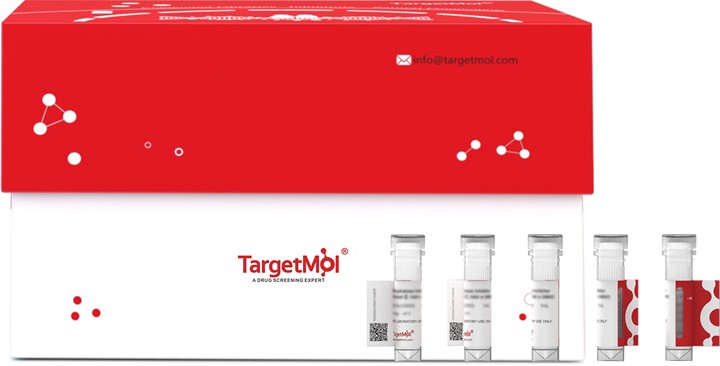 Your shopping cart is currently empty
Your shopping cart is currently empty
Siglec-7 Protein,Human,Recombinant (aa 19-353, His)
Siglecs (sialic acid binding Ig-like lectins) are I-type (Ig-type) lectins belonging to the Ig superfamily. They are characterized by an N-terminal Ig-like V-type domain which mediates sialic acid binding, followed by varying numbers of Ig-like C2-type domains. Eleven human Siglecs have been cloned and characterized. Human Siglec-7 encodes a 467 amino acid (aa) polypeptide with a hydrophobic signal peptide, an N-terminal Ig-like V-type domain, two Ig-like C2-type domains, a transmembrane region and a cytoplasmic tail. Siglec-7 exists as a monomer on the cell surface and is expressed on natural killer cells, CD8+ T cells and monocytes. It binds equally well to both alpha 2,3- and alpha 2,6-linked sialic acid. The gene encoding Siglec-7 was mapped to chromosome 19q13.3.

Siglec-7 Protein,Human,Recombinant (aa 19-353, His)
| Pack Size | Price | USA Warehouse | Global Warehouse | Quantity |
|---|---|---|---|---|
| 5 μg | $138 | 7-10 days | 7-10 days | |
| 10 μg | $228 | 7-10 days | 7-10 days | |
| 20 μg | $365 | 7-10 days | 7-10 days | |
| 50 μg | $687 | 7-10 days | 7-10 days | |
| 100 μg | $987 | 7-10 days | 7-10 days | |
| 200 μg | $1,490 | 7-10 days | 7-10 days | |
| 500 μg | $2,510 | 7-10 days | 7-10 days | |
| 1 mg | $3,790 | 7-10 days | 7-10 days |
Product Information
| Biological Activity | Activity has not been tested. It is theoretically active, but we cannot guarantee it. If you require protein activity, we recommend choosing the eukaryotic expression version first. |
| Description | Siglecs (sialic acid binding Ig-like lectins) are I-type (Ig-type) lectins belonging to the Ig superfamily. They are characterized by an N-terminal Ig-like V-type domain which mediates sialic acid binding, followed by varying numbers of Ig-like C2-type domains. Eleven human Siglecs have been cloned and characterized. Human Siglec-7 encodes a 467 amino acid (aa) polypeptide with a hydrophobic signal peptide, an N-terminal Ig-like V-type domain, two Ig-like C2-type domains, a transmembrane region and a cytoplasmic tail. Siglec-7 exists as a monomer on the cell surface and is expressed on natural killer cells, CD8+ T cells and monocytes. It binds equally well to both alpha 2,3- and alpha 2,6-linked sialic acid. The gene encoding Siglec-7 was mapped to chromosome 19q13.3. |
| Species | Human |
| Expression System | HEK293 Cells |
| Tag | C-6xHis |
| Accession Number | Q9Y286 |
| Synonyms | siglec-7,Siglec7,sialic acid-binding Ig-like lectin 7,sialic acid binding Ig-like lectin 7,QA79,p75/AIRM1,p75,D-siglec,CDw328,CD328 antigen,CD328,AIRM1QA79 membrane protein,AIRM-1,AIRM1 |
| Amino Acid | Gln19-Leu353 |
| Construction | Gln19-Leu353 |
| Protein Purity | Greater than 95% as determined by reducing SDS-PAGE. (QC verified) |
| Molecular Weight | 50-70 KDa (reducing condition) |
| Endotoxin | < 0.1 ng/µg (1 EU/µg) as determined by LAL test. |
| Formulation | Lyophilized from a solution filtered through a 0.22 μm filter, containing PBS, pH 7.4. |
| Reconstitution | Reconstitute the lyophilized protein in distilled water. The product concentration should not be less than 100 μg/ml. Before opening, centrifuge the tube to collect powder at the bottom. After adding the reconstitution buffer, avoid vortexing or pipetting for mixing. |
| Stability & Storage | Lyophilized powders can be stably stored for over 12 months, while liquid products can be stored for 6-12 months at -80°C. For reconstituted protein solutions, the solution can be stored at -20°C to -80°C for at least 3 months. Please avoid multiple freeze-thaw cycles and store products in aliquots. |
| Shipping | In general, Lyophilized powders are shipping with blue ice. Solutions are shipping with dry ice. |
| Research Background | Siglecs (sialic acid binding Ig-like lectins) are I-type (Ig-type) lectins belonging to the Ig superfamily. They are characterized by an N-terminal Ig-like V-type domain which mediates sialic acid binding, followed by varying numbers of Ig-like C2-type domains. Eleven human Siglecs have been cloned and characterized. Human Siglec-7 encodes a 467 amino acid (aa) polypeptide with a hydrophobic signal peptide, an N-terminal Ig-like V-type domain, two Ig-like C2-type domains, a transmembrane region and a cytoplasmic tail. Siglec-7 exists as a monomer on the cell surface and is expressed on natural killer cells, CD8+ T cells and monocytes. It binds equally well to both alpha 2,3- and alpha 2,6-linked sialic acid. The gene encoding Siglec-7 was mapped to chromosome 19q13.3. |
Dose Conversion
Calculator
Tech Support
| Size | Quantity | Unit Price | Amount | Operation |
|---|

Copyright © 2015-2025 TargetMol Chemicals Inc. All Rights Reserved.



